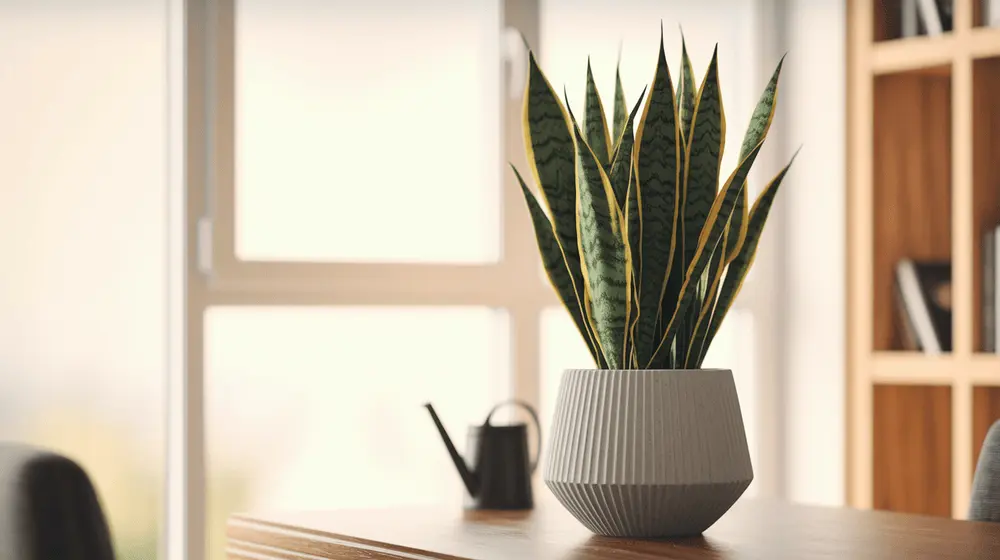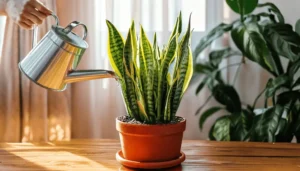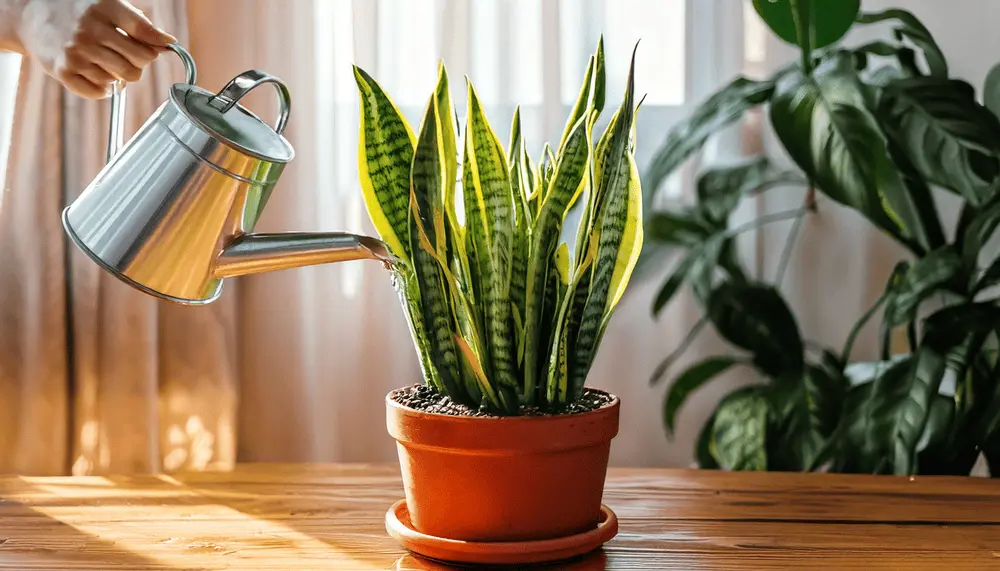Snake Plant Care: Snake plants are one of the easiest houseplants to care for. They need very little water, can survive in low light, and thrive with minimal attention. If you’re new to houseplants or just want a low-maintenance, air-purifying plant, the snake plant is a perfect choice.
In this article, we’ll discuss everything you need to know about taking care of a snake plant. From watering and lighting to soil and repotting, we’ll cover all the basics. If you’ve ever wondered how often to water, where to place it, or why the leaves are turning yellow, this guide will help you keep your snake plant healthy and happy!
Why Do People Love Snake Plants?
People love snake plants because they are easy to care for and look great in any room. They purify the air by removing toxins like formaldehyde and benzene. This plant is also drought-resistant, making it perfect for busy people. It survives in low light and small spaces, which is why it’s popular in homes and offices. *(Interlink: Snake Plant Indoor Benefits) *
Watering Tips: Snake Plant Care Tips
How Much Water Does a Snake Plant Need?
Snake plants do not need much water. Their thick leaves store water, just like succulents. Watering once every 2–3 weeks is usually enough. In winter, they need even less water because they grow slowly. Always check the soil before watering to avoid problems.
How to Avoid Overwatering?
Overwatering is the biggest mistake people make. Too much water causes root rot, which can kill the plant. Always use a pot with drainage holes so extra water can escape. Before watering, touch the soil—if it feels dry, it’s time to water. If it’s still damp, wait a few more days.
Signs of a Thirsty Snake Plant
A snake plant shows clear signs when it needs water. If the leaves wrinkle or curl, it means they are dehydrated. Dry, crispy leaf tips also mean the plant is thirsty. If the leaves look dull and weak, water the plant and it will perk up soon. *(Interlink: Snake Plant Drooping) *

Removes Toxins *(Interlink: Snake Plant Health Benefits) *
Acts as a Natural Air Purifier
A snake plant is more than just a pretty plant—it is a natural air purifier. It absorbs toxins and releases fresh oxygen into the air. NASA even listed it as one of the best air-purifying plants. Keeping a snake plant indoors can make your home healthier and fresher.
Absorbs Harmful Chemicals
Everyday household items like furniture, paints, and cleaning products release harmful chemicals into the air. Snake plants help by absorbing toxins like formaldehyde, benzene, and xylene. These chemicals can cause headaches, allergies, and breathing issues, so having a snake plant can help reduce their effects.
Improves Indoor Air Quality
Snake plants work best in small spaces where air circulation is poor. They remove toxins even at night, making them perfect for bedrooms and offices. Placing a few snake plants around the house can create a cleaner and fresher indoor environment. *(Interlink: Snake Plant Indoor Benefits) *
Soil Requirements to Take Care Snake Plant*(Interlink: Best Soil for Snake Plant) *
What Soil Is Best for Snake Plants?
Snake plants need well-draining soil to stay healthy. The best option is a succulent or cactus mix because it allows water to drain quickly. You can also make your own mix by combining potting soil, sand, and perlite. This helps prevent excess moisture, which can lead to root rot.
Why Does Drainage Matter?
Good drainage is very important for snake plants. If the soil holds too much water, the roots will start to rot and decay. Using a fast-draining soil mix and a pot with drainage holes helps keep the roots dry and healthy. Always make sure the pot is not sitting in standing water.
Signs of Bad Soil
Bad soil can cause many problems for a snake plant. If the soil stays wet for too long, it is too dense and needs better drainage. Mushy roots, yellow leaves, and a bad smell are signs of root rot. If the soil dries out too quickly, it might not have enough nutrients. In that case, mix in some organic compost for better growth. *(Interlink: Snake Plant Yellow Leaves) *

Fertilizer Needs to Take Care Snake Plant*(Interlink: Snake Plant Fertilizer) *
Does a Snake Plant Need Fertilizer?
Snake plants do not need a lot of fertilizer. They grow well even in poor soil. However, a little fertilizer helps them grow faster and healthier. If you want bigger and stronger leaves, feeding your snake plant is a good idea.
What Type of Fertilizer Is Best?
A balanced liquid fertilizer is the best choice. Look for one with an NPK ratio of 10-10-10 or 20-20-20. You can also use succulent or cactus fertilizer. Avoid strong fertilizers because too many nutrients can burn the roots. Always dilute the fertilizer before using it.
How Often Should You Use It to take care Snake Plant?
Fertilizing once every 1–2 months during spring and summer is enough. Snake plants grow slowly, so they do not need frequent feeding. In fall and winter, stop fertilizing. The plant rests during this time and does not need extra nutrients. *(Interlink: Snake Plant Growth)
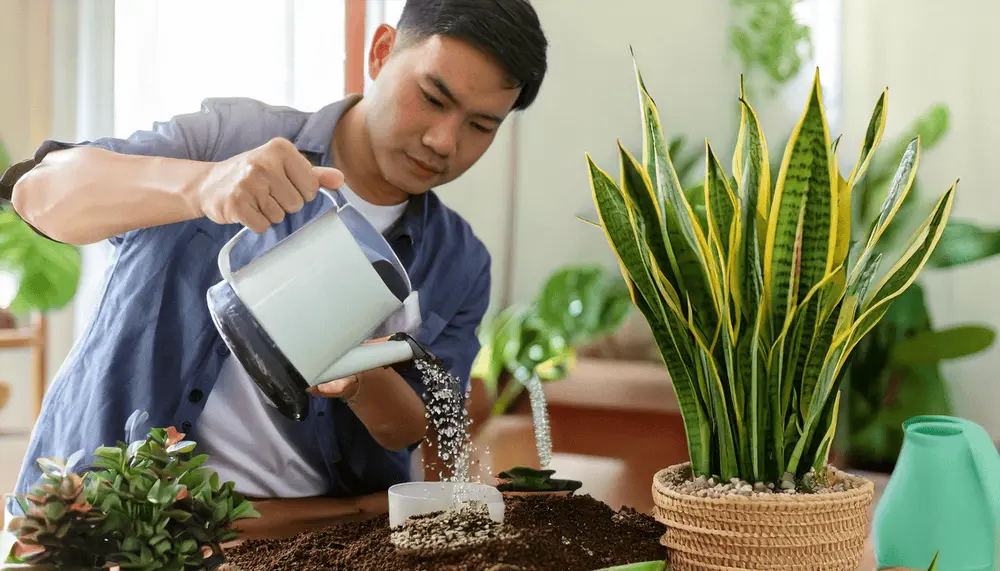
Common Problems & Solutions *(Interlink: Snake Plant Yellow Leaves, Snake Plant Drooping) *
Why Do Leaves Turn Yellow?
Yellow leaves are a sign that something is wrong. The most common reason is overwatering. When the soil stays too wet, the roots rot, and the leaves turn yellow and mushy. Too much direct sunlight can also burn the leaves, causing them to change color. Sometimes, a lack of nutrients makes the leaves turn pale.
Why Does the Plant Droop?
A healthy snake plant has firm, upright leaves. If the plant starts drooping, it usually means too much water or not enough light. Soft, weak leaves can also be a sign of root rot. Sometimes, the plant becomes too heavy, and the leaves bend under their weight.
How to Fix These Problems?
To fix yellow leaves, stop watering for a while and let the soil dry out completely. If the roots are rotting, remove the damaged parts and repot the plant in fresh, well-draining soil.
For drooping leaves, check if the plant is getting enough light. Move it to a brighter spot but avoid harsh direct sunlight. If the plant is too top-heavy, use a stake to support the leaves or repot it in a deeper container. *(Interlink: Best Soil for Snake Plant) *
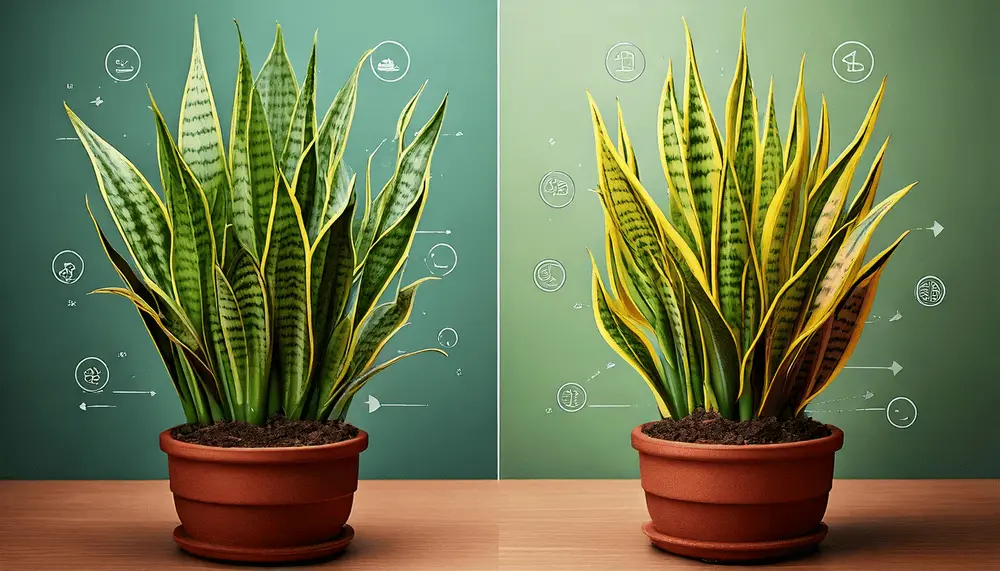
Potting and Repotting Tips *(Interlink: Snake Plant Pot, Snake Plant Repotting) *
How to Pick the Right Pot?
Choosing the right pot is important for a healthy snake plant. Always use a pot with drainage holes to prevent water from sitting in the soil. Terracotta pots are a great choice because they absorb extra moisture, keeping the soil dry. The pot should be slightly bigger than the plant’s root ball so it has room to grow but doesn’t hold too much water. *(Interlink: Snake Plant in Terracotta Pot) *
When Should You Repot?
Snake plants grow slowly, so they don’t need frequent repotting. Repotting is necessary every 2–3 years or when the roots start pushing out of the pot. If the plant looks too crowded, or the soil dries out too quickly, it might be time for a new pot.
Steps to Repot a Snake Plant
- Choose a new pot—make sure it is one size bigger than the current one.
- Prepare fresh soil—use a well-draining succulent or cactus mix. *(Interlink: Best Soil for Snake Plant) *
- Gently remove the plant from its old pot. Shake off excess soil from the roots.
- Check the roots—if you see any rotting parts, cut them off with clean scissors.
- Place the plant in the new pot and fill it with fresh soil, pressing lightly.
- Water lightly—do not overwater after repotting. Let the plant adjust to its new home.
After repotting, keep the plant in indirect light for a few days to help it recover.

Snake Plant Seasonal Care Guide
How to Care for a Snake Plant in Winter?
Snake plants need less water in winter. The cold weather slows down their growth, so overwatering can cause root rot. Water only once a month or when the soil feels completely dry. Keep the plant away from cold drafts and heaters, as extreme temperatures can damage the leaves. If your home gets very dry, a humidifier can help keep the air balanced.
How to Care for a Snake Plant in Summer?
Summer is the growing season for snake plants. They need more water but still don’t like soggy soil. Water every 1–2 weeks, depending on how quickly the soil dries. Bright indirect sunlight helps the plant grow well, but too much direct sunlight can scorch the leaves. If placing the plant outside, keep it in a shaded area. Adding fertilizer once a month during this season can promote growth. *(Interlink: Snake Plant Fertilizer) *
Should Care Change in Different Seasons?
Yes! Snake plants need different care depending on the season. In winter, they need less water and warmth. In summer, they need more light and water. During spring and fall, keep watering moderate and repot if needed. *(Interlink: Snake Plant Repotting) * Proper care in each season keeps your snake plant healthy and thriving all year round!

Conclusion
Why Is the Snake Plant the Best Choice?
The snake plant is one of the easiest houseplants to grow. It looks beautiful, needs very little care, and cleans the air. It survives in low light, requires minimal watering, and adds a modern touch to any home. Whether you’re a beginner or an experienced plant lover, the snake plant is a perfect choice. *(Interlink: Snake Plant Indoor Benefits) *
Quick Tips for Keeping It Happy
- Water sparingly—only when the soil is completely dry. *(Interlink: How Often to Water Snake Plant) *
- Give it indirect light—it thrives in low to bright light. *(Interlink: Snake Plant Light Requirements) *
- Use well-draining soil—a cactus or succulent mix works best. *(Interlink: Best Soil for Snake Plant) *
- Fertilize occasionally—once every 1–2 months in spring and summer. *(Interlink: Snake Plant Fertilizer) *
- Repot every few years—if the roots outgrow the pot. *(Interlink: Snake Plant Repotting) *
Where to Buy a Snake Plant?
Snake plants are widely available. You can find them at local nurseries, garden centers, and online stores. Many online retailers offer different varieties and sizes to fit your space. *(Interlink: Buy Snake Plant) *
With the right care, your snake plant will stay happy and healthy for years!
